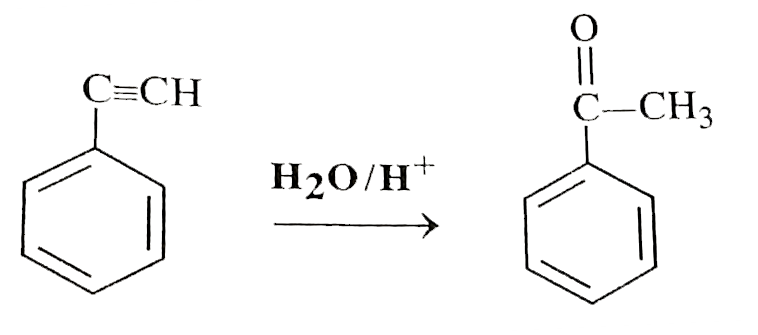Accomplish the following conversions :
Chlorobenzene to p-bromoaniline
To convert chlorobenzene to p-bromoaniline, we will follow a series of chemical reactions. Here’s a step-by-step breakdown of the process:
Step 1: Formation of Benzyne
- Starting Material: Chlorobenzene (C6H5Cl)
- Reagent: A strong base, such as sodium amide (NaNH2) or lithium diisopropylamide (LDA).
- Reaction: The base will extract a hydrogen atom from the benzene ring, leading to the formation of benzyne (C6H4) as an intermediate. The chlorine atom leaves as a chloride ion (Cl⁻).
Equation:
C6H5Cl+NaNH2→C6H4+NaCl+NH3
Step 2: Nucleophilic Attack by Ammonia
- Reagent: Ammonia (NH3)
- Reaction: The ammonia will act as a nucleophile and attack the benzyne intermediate, leading to the formation of an amino group (NH2) on the aromatic ring.
Equation:
C6H4+NH3→C6H4NH2
Step 3: Acetylation of Aniline
- Reagent: Acetyl chloride (CH3COCl)
- Reaction: The amino group of aniline is acetylated to form acetanilide (C6H5NHCOCH3). This protects the amino group during subsequent electrophilic substitution reactions.
Equation:
C6H5NH2+CH3COCl→C6H5NHCOCH3+HCl
Step 4: Bromination of Acetanilide
- Reagent: Bromine (Br2) in the presence of a Lewis acid catalyst like iron (Fe).
- Reaction: The acetanilide undergoes electrophilic substitution at the para position due to the electron-donating effect of the amino group. The bromine will preferentially attack the para position due to steric hindrance at the ortho position.
Equation:
C6H5NHCOCH3+Br2→p-Br-C6H4NHCOCH3
Step 5: Hydrolysis of Acetanilide
- Reagent: Water (H2O)
- Reaction: The acetanilide is hydrolyzed to regenerate the amino group, yielding p-bromoaniline.
Equation:
p-Br-C6H4NHCOCH3+H2O→p-Br-C6H4NH2+CH3COOH
Final Product
The final product of this series of reactions is p-bromoaniline (p-Br-C6H4NH2).
---
- Starting Material: Chlorobenzene (C6H5Cl)
- Reagent: A strong base, such as sodium amide (NaNH2) or lithium diisopropylamide (LDA).
- Reaction: The base will extract a hydrogen atom from the benzene ring, leading to the formation of benzyne (C6H4) as an intermediate. The chlorine atom leaves as a chloride ion (Cl⁻).
Equation:
C6H5Cl+NaNH2→C6H4+NaCl+NH3
- Reagent: Ammonia (NH3)
- Reaction: The ammonia will act as a nucleophile and attack the benzyne intermediate, leading to the formation of an amino group (NH2) on the aromatic ring.
C6H4+NH3→C6H4NH2
- Reagent: Acetyl chloride (CH3COCl)
- Reaction: The amino group of aniline is acetylated to form acetanilide (C6H5NHCOCH3). This protects the amino group during subsequent electrophilic substitution reactions.
C6H5NH2+CH3COCl→C6H5NHCOCH3+HCl
- Reagent: Bromine (Br2) in the presence of a Lewis acid catalyst like iron (Fe).
- Reaction: The acetanilide undergoes electrophilic substitution at the para position due to the electron-donating effect of the amino group. The bromine will preferentially attack the para position due to steric hindrance at the ortho position.
C6H5NHCOCH3+Br2→p-Br-C6H4NHCOCH3
- Reagent: Water (H2O)
- Reaction: The acetanilide is hydrolyzed to regenerate the amino group, yielding p-bromoaniline.
p-Br-C6H4NHCOCH3+H2O→p-Br-C6H4NH2+CH3COOH
The final product of this series of reactions is p-bromoaniline (p-Br-C6H4NH2).
Topper's Solved these Questions
- ORGANIC COMPOUNDS WITH FUNCTIONAL GROUPBOOK - CENGAGE CHEMISTRY ENGLISHCHAPTER - ORGANIC COMPOUNDS WITH FUNCTIONAL GROUPEXERCISE - concept application 4
1 Videos
- ORGANIC COMPOUNDS WITH FUNCTIONAL GROUPBOOK - CENGAGE CHEMISTRY ENGLISHCHAPTER - ORGANIC COMPOUNDS WITH FUNCTIONAL GROUPEXERCISE - Exercises Linked Comprehension
25 Videos
- ORGANIC COMPOUNDS WITH FUNCTIONAL GROUPBOOK - CENGAGE CHEMISTRY ENGLISHCHAPTER - ORGANIC COMPOUNDS WITH FUNCTIONAL GROUPEXERCISE - Exercises Subjective
21 Videos
- NUCLEAR CHEMISTRYBOOK - CENGAGE CHEMISTRY ENGLISHCHAPTER - NUCLEAR CHEMISTRYEXERCISE - Archives Subjective
13 Videos
- P-BLOCK GROUP 15 ELEMENTS - THE NITROGEN FAMILYBOOK - CENGAGE CHEMISTRY ENGLISHCHAPTER - P-BLOCK GROUP 15 ELEMENTS - THE NITROGEN FAMILYEXERCISE - Exercises Archives (Subjective)
28 Videos
Similar Questions
Knowledge Check
Which of the following conversions is correct ?
A1 atm =1.01×104 PaB1 mm of Hg =133 PaC1 bar =107 PaD1 torr =102 PaWhich of the following conversions is incorrect?
A1 curie =3.7×1010g−1B1 barn =10−25m2C1 quintal =100kgD1 litre =10−3m3
Conversion of Chlorobenzene to benzene
View SolutionChlorobenzene to 2-chlorotoluene
View SolutionHow will you convert :
Chlorobenzene to phenol
View SolutionConversion of Aniline to p-bromoaniline
View SolutionHow can the following conversions be brought about :
Nitrobenzene to p-aminoazobenzene.
View SolutionHow can the following conversions be brought about :
Nitrobenzene to p-aminoazobenzene
View Solution

